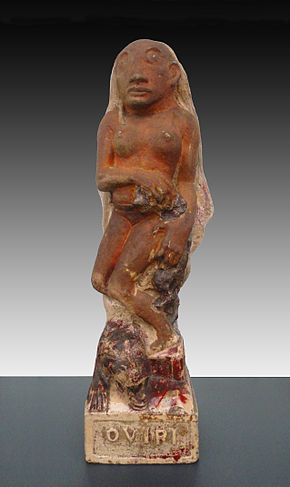Introduction

The visual arts are art forms such as painting, drawing, printmaking, sculpture, ceramics, photography, video, filmmaking, comics, design, crafts, and architecture. Many artistic disciplines, such as performing arts, conceptual art, and textile arts, also involve aspects of the visual arts as well as arts of other types. Also included within the visual arts are the applied arts, such as industrial design, graphic design, fashion design, interior design, and decorative art.
Current usage of the term "visual arts" includes fine art as well as applied or decorative arts and crafts, but this was not always the case. Before the Arts and Crafts Movement in Britain and elsewhere at the turn of the 20th century, the term 'artist' had for some centuries often been restricted to a person working in the fine arts (such as painting, sculpture, or printmaking) and not the decorative arts, crafts, or applied visual arts media. The distinction was emphasized by artists of the Arts and Crafts Movement, who valued vernacular art forms as much as high forms. Art schools made a distinction between the fine arts and the crafts, maintaining that a craftsperson could not be considered a practitioner of the arts. The increasing tendency to privilege painting, and to a lesser degree sculpture, above other arts has been a feature of Western art as well as East Asian art. In both regions, painting has been seen as relying to the highest degree on the imagination of the artist and being the furthest removed from manual labour – in Chinese painting, the most highly valued styles were those of "scholar-painting", at least in theory practiced by gentleman amateurs. The Western hierarchy of genres reflected similar attitudes. (Full article...)
Selected article

Oviri (Tahitian for savage or wild) is an 1894 ceramic sculpture by the French artist Paul Gauguin. In Tahitian mythology, Oviri was the goddess of mourning and is shown with long pale hair and wild eyes, smothering a wolf with her feet while clutching a cub in her arms. Art historians have presented multiple interpretations—usually that Gauguin intended it as an epithet to reinforce his self-image as a "civilised savage". Tahitian goddesses of her era had passed from folk memory by 1894, yet Gauguin romanticises the island's past as he reaches towards more ancient sources, including an Assyrian relief of a "master of animals" type, and Majapahit mummies. Other possible influences include preserved skulls from the Marquesas Islands, figures found at Borobudur, and a 9th-century Mahayana Buddhist temple in central Java.
Gauguin made three casts, each in partially glazed stoneware, and while several copies exist in plaster or bronze, the original cast is in the Musée d'Orsay. His sales of the casts were not successful, and at a low financial and personal ebb he asked for one to be placed on his grave. There are only three other surviving comments of his on the figure: he described the figure as a strange and cruel enigma on an 1895 presentation mount of two impressions of a woodcut of Oviri for Stéphane Mallarmé; he referred to it as La Tueuse ("The Murderess") in an 1897 letter to Ambroise Vollard; and he appended an inscription referencing Honoré de Balzac's novel Séraphîta in a c. 1899 drawing. Oviri was exhibited at the 1906 Salon d'Automne (no. 57) where it influenced Pablo Picasso, who based one of the figures in Les Demoiselles d'Avignon on it. (Full article...)Selected picture
Selected quote
| “ | Most painting in the European tradition was painting the mask. Modern art rejected all that. Our subject matter was the person behind the mask. | ” |
| — Robert Motherwell, The Times (November 17, 1985) |
Related portals
Selected biography

Jean Bellette (occasionally Jean Haefliger; 25 March 1908 – 16 March 1991) was an Australian artist. Born in Tasmania, she was educated in Hobart and at Julian Ashton's art school in Sydney, where one of her teachers was Thea Proctor. In London she studied under painters Bernard Meninsky and Mark Gertler.
A modernist painter, Bellette was influential in mid-twentieth century Sydney art circles. She frequently painted scenes influenced by the Greek tragedies of Euripides and Sophocles and the epics of Homer. The only woman to have won the Sulman Prize more than once, Bellette claimed the accolade in 1942 with For Whom the Bell Tolls, and in 1944 with Iphigenia in Tauris. She helped found the Blake Prize for Religious Art, and was its inaugural judge. Bellette married artist and critic Paul Haefliger in 1935. The couple moved to Majorca in 1957; although she visited and exhibited in Australia thereafter, she did not return there to live, and became peripheral to the Australian art scene. (Full article...)Did you know (auto generated) -

- ... that the art of Irma Blank, of "drawing languages without words" and including sounds, was recognised in the 1970s but fell into obscurity until a rediscovery in the 2010s?
- ... that The Wiccan Web recommends drawing pentagrams on your computer screen with tinctures?
- ... that Bernie Wrightson spent seven years drawing an illustrated edition of Mary Shelley's 1818 novel Frankenstein?
- ... that Nickelodeon storyboard artists created a book with hundreds of pornographic drawings of SpongeBob SquarePants characters?
- ... that the documentary comedy films Being Canadian and When Jews Were Funny explore the filmmakers' cultural identity through interviews with dozens of comedians?
- ... that in 1933 Nazi sympathisers attempted to kidnap two German-Jewish filmmakers in Liechtenstein?
- ... that Kip Andersen and Keegan Kuhn were co-nominees for the 2018 Cinema for Peace Award for their documentary What the Health?
- ... that gender-swapped drawings of Finn the Human, the main character of Adventure Time, inspired their own spin-off series?
General images
Major topics
- Types of visual art – Architecture • Art intervention • Ceramic art • Computer art • Drawing • Fashion • Film • Installation art • Land art • Mixed media • Painting • Performance art • Photography • Printmaking • Sculpture • Stained glass
- Art history – Pre-historic art • Ancient art • Art of Ancient Egypt • Art in Ancient Greece • Minoan pottery • Scythian art • Roman art • Women artists
- Western art periods and movements – Medieval art • Gothic art • Renaissance • Mannerism • Baroque • Rococo • Neoclassicism • Romanticism • Realism • Modern Art • Impressionism • Symbolism • Fauvism • Proto-Cubism • Cubism • Futurism • Dada • Art Deco • Surrealism • Abstract Expressionism • Lyrical abstraction • Conceptual Art • Contemporary Art • Postmodern art visual arts.
- Eastern and Middle Eastern art – Buddhist art • Chinese art • Islamic art • Japanese art • Laotian art • Thai art • Tibetan art
- Lists – Architects • Art movements • Art periods • Painters • Printmakers • Sculptors • Statues
- Lists of basic topics – Visual arts • Architecture • Film • Painting • Photography • Sculpture
Subcategories

Architecture | Ceramic art | Comics | Crafts | Design | Drawing | Illustration | Film | Glass | Graphic design | Industrial design | Landscape architecture | Multimedia | Painting | Photography | Pottery | Printmaking | Public art | Sculpture | Typography | Mosaic
Artists | Visual arts awards | Artist collectives | Art collectors | Art critics | Art curators | Visual arts exhibitions | Art forgery | Art history | Visual arts materials | Art schools | Artistic techniques |
WikiProjects
Things you can do
Associated Wikimedia
The following Wikimedia Foundation sister projects provide more on this subject:
-
Commons
Free media repository -
Wikibooks
Free textbooks and manuals -
Wikidata
Free knowledge base -
Wikinews
Free-content news -
Wikiquote
Collection of quotations -
Wikisource
Free-content library -
Wikiversity
Free learning tools -
Wiktionary
Dictionary and thesaurus














































































